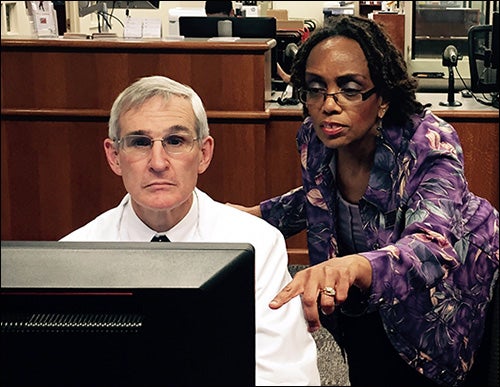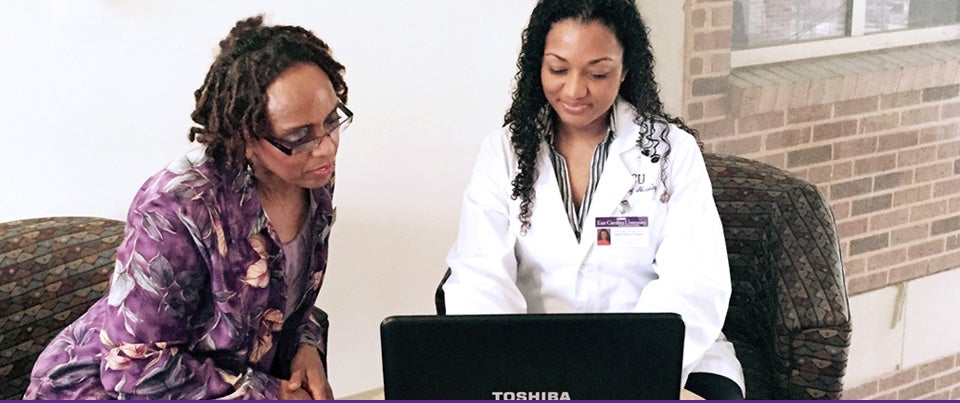TEACHING TEAMWORK
ECU rolls out first interprofessional virtual patient case
Students and residents representing three of East Carolina University’s health sciences programs recently participated in the university’s first interprofessional virtual patient case.
Between April 6 and 10, a dozen nurse-midwifery students from the College of Nursing, four general dentistry residents from the School of Dental Medicine and a medical student from the Brody School of Medicine collaborated online in small teams to formulate an interprofessional plan of care for a virtual patient created by ECU faculty from multiple disciplines.

ECU nursing professor Dr. Pamela Reis, right, shows virtual patient details to Dr. Robert Carter, director of the General Practice Residency program for the ECU School of Dental Medicine.
“Almost all of ECU’s graduate nursing programs are offered primarily online, and because we have students from across the state and from neighboring states, creating face-to-face learning opportunities with learners from different disciplines is challenging and fraught with barriers,” said Dr. Pamela Reis, an assistant professor of nursing in the College of Nursing who spearheaded the project.
Funded through a Health Resources and Services Administration grant, the pilot project employed a new learning management system called the Vertical Education System. Reis said ECU is the fourth school in the nation to use this innovative, web-based learning platform designed by faculty at Virginia Commonwealth University.
The program’s simulated, interactive electronic health record allows the virtual patient’s health history to be saved so the case can continue to unfold over subsequent semesters, Reis explained.
In this first scenario, a young woman was referred for health care by the criminal justice system due to her methamphetamine addiction, a growing problem in eastern North Carolina. This patient also had oral, gynecologic and mental health issues in addition to unmet primary care needs. As her case evolves, the patient will become pregnant and eventually develop a serious health condition that will require continued collaborative care, Reis said.
“We’d eventually like to use the case as a six-to-12-week curricular activity involving all the health sciences, and maybe even span multiple semesters,” Reis said. She added that organizers envision a consortium wherein all universities using the platform will contribute and borrow patient cases from each other.
Dr. Robert Carter, director of the General Practice Residency program for the School of Dental Medicine, said this project “teaches a dentist how to be an effective member of an interprofessional team.
“This exercise increases knowledge of other resources and support systems available to patients – such as different health care disciplines, social services and counseling – which all play a part in helping people with multifaceted needs,” said Carter.
“It also helps learners develop professional relationships across system boundaries, which results in an improved referral process and better collaboration in assessing and treating patients with a variety of problems,” he said.
Vertical Education System administrators can access a wide range of reports detailing team performance as well as an individual learner’s mastery of domain-specific knowledge.
Other faculty members who helped with the project include clinical assistant professor Dr. Janet Tillman in the College of Nursing, and assistant professor Dr. Kelly Reinsmith-Jones from the School of Social Work in the College of Human Ecology. Also from the College of Human Ecology, Dr. Megan Davidson and Dr. Mark Jones in the Department of Criminal Justice contributed their expertise.
